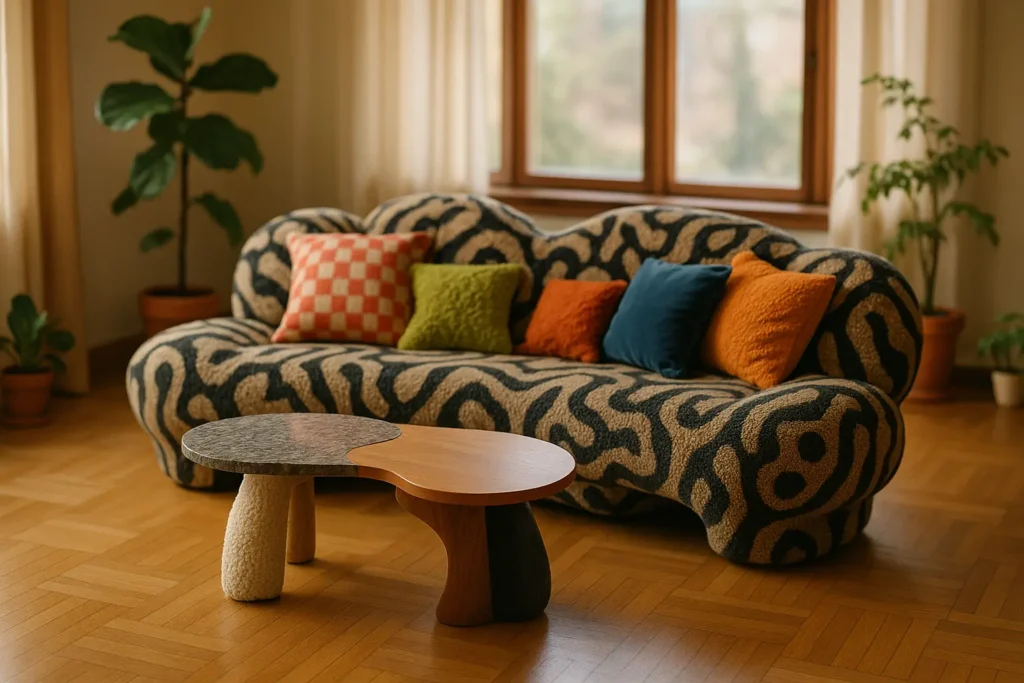“Beauty is in the eye of the beholder,” as the old adage goes, has never been more relevant than in today’s interior design landscape. We’ve seen a fascinating evolution in the world of furniture design over the years. From sleek, polished pieces that ooze sophistication to the so-called “ugly” furniture that seems to defy traditional aesthetics, the style preferences of homeowners and interior decorators are undeniably shifting. But why exactly has the concept of “ugly” furniture taken such a hold on our collective imagination?
In this article, we aim to unravel the mystery of this viral trend and explore why “ugly” pieces are captivating our hearts and homes. Our journey will delve into the psychology behind design choices and how these seemingly unattractive pieces can transform a room into something truly mesmerizing. So, let’s embark on this exploration of style, where the unconventional reigns supreme.
The Allure of “Ugly” Furniture
First impressions matter, but when it comes to furniture, they might not tell the whole story. What initially appears unattractive may possess hidden depths of charm and character. The so-called “ugly” furniture has an undeniable allure, one that challenges conventional notions of beauty and design. Some might even argue that it is precisely within these imperfections that we find the true essence of style.
Think of those bold, clashing colors or that peculiar shape of a chair. At first glance, such idiosyncrasies might seem out of place or even downright bizarre. But upon closer inspection, they reveal a depth of personality and quirkiness that standard pieces simply lack. Ugly furniture dares to be different, and in a world of uniformity, that’s a quality worth celebrating.
Moreover, by choosing to embrace the “ugly,” we give ourselves permission to be more playful and adventurous with our interiors. We break free from the shackles of traditional decor, inviting a sense of creative experimentation. When a piece doesn’t conform to the usual standards, it encourages us to think outside the box, crafting spaces that are both unique and personal.
It’s also worth considering the sustainability aspect of these pieces. Often, what is deemed “ugly” stems from vintage and retro designs, which means they have withstood the test of time. By choosing such furniture, we’re embracing second-hand, environmentally-friendly options that add authentic depth to our homes.
Integrating Ugly Furniture Into a Cohesive Design
While the eccentricity of “ugly” furniture has its appeal, incorporating it into a cohesive interior can be challenging. How do we ensure that these bold pieces enhance rather than jar against the overall ambiance of a room?
The first step is to choose a focal point. Whether it’s a vividly colored sofa or a table with a unique form, allow this piece to take center stage. When the rest of the decor is curated around this central element, it can transform from an eyesore to an eye-catcher, drawing admiration instead of bewilderment.
Additionally, pairing the “ugly” piece with complementary elements can create harmony. For instance, a boldly designed chair might pair wonderfully with muted tones, allowing its uniqueness to shine without overwhelming the space. Conversely, using contrasting textures and colors throughout the living area can create a vibrant tapestry, breathing life into every corner.
Balance is another crucial factor. Ensure that the unusual piece doesn’t dominate but instead complements the other elements in the room. Achieving a balance between busy and serene areas will make a “ugly” design feel intentionally stylish rather than haphazard.
Lastly, consider how these pieces fit into everyday life. Functionality should never be sacrificed for aesthetics. A bold statement piece doesn’t need to be impractical. It can serve as a conversation starter while still fulfilling its purpose effectively.
The Psychological Appeal of the Unconventional
Our affinity for the unconventional can often be traced back to psychological roots. Embracing “ugly” furniture goes beyond aesthetics—it’s an expression of our individuality and a reflection of our ever-evolving tastes.
In a world that frequently tells us to conform, choosing an unconventional piece can feel rebellious and liberating. It serves as a declaration of our autonomy and a testament to the courage it takes to defy the norms that dictate how our homes should look. It’s about making a space uniquely ours and letting our personality shine through every chosen piece.
Moreover, there’s a sense of nostalgia attached to these designs. Retro and vintage pieces remind us of bygone days, stirring memories and evoking emotions. There’s an inexplicable comfort in surrounding ourselves with pieces that have a history, a story to tell. It anchors us to the past while allowing us to forge new memories in the present.
Additionally, embracing the “ugly” challenges us to see beauty differently. It encourages us to venture beyond surface-level appearances and seek deeper connections to the objects we use daily. This approach to design can foster a greater sense of contentment and satisfaction within our spaces, reminding us that perfection isn’t always the goal.
As we navigate through the ever-changing world of interior design, the allure of “ugly” furniture becomes more apparent. It challenges us to break free from conventional aesthetics and embrace pieces that uniquely reflect our personalities. With its ability to transform spaces and evoke powerful emotions, “ugly” furniture transcends its name, proving that beauty truly is in the eye of the beholder.
By daring to incorporate these unconventional designs into our homes, we’re not just following a trend. We’re making a statement—a bold testament to our creativity, individuality, and love for all things quirky and bold. So, let’s celebrate the beauty in the beast and create interiors that speak volumes about who we are and what we love.
FAQ
Why is ugly furniture becoming popular in modern decor?
The trend towards “ugly” furniture, often characterized by bold colors, unusual shapes, and unconventional materials, is gaining traction as it challenges traditional aesthetics and celebrates individuality and uniqueness in home decor.
What defines “ugly” furniture in today’s design landscape?
“Ugly” furniture typically includes pieces that defy standard beauty norms, featuring clashing colors, asymmetrical designs, or unexpected textures that make a statement and often serve as conversation starters.
How can ugly furniture contribute to a room’s overall aesthetic?
By incorporating ugly furniture, rooms are transformed into vibrant and eclectic spaces that reflect personal taste and creativity. These pieces can act as focal points that inject personality and character into otherwise neutral settings.
Are there any historical influences on the ugly furniture trend?
Yes, the ugly furniture trend draws inspiration from various historical design movements such as Brutalism and the Memphis Group, both of which prioritized boldness and innovation over conventional beauty.
What are some practical tips for integrating ugly furniture into a home?
To successfully integrate ugly furniture, balance is key. Pair statement pieces with understated decor to prevent overwhelming the space. Additionally, consider the scale and functionality of the furniture to ensure it complements the existing layout and meets practical needs.



